 One idea that comes to mind for many people looking to save water in their landscape is to incorporate rocks and boulders. They can be a beautiful addition to your landscape if they are designed and installed artfully, but if they aren’t done with a careful eye, they can seem out of place and very unnatural on the site.
One idea that comes to mind for many people looking to save water in their landscape is to incorporate rocks and boulders. They can be a beautiful addition to your landscape if they are designed and installed artfully, but if they aren’t done with a careful eye, they can seem out of place and very unnatural on the site.
If you have existing boulders on the site and you are considering adding more, make sure the new boulders are as close of a match as you can find so that they blend in. By far the best selection of boulders nearby is at Southwest Boulder and Stone in Fallbrook. For those of us coming from the city center, it is a long drive, but well worth it. They offer over 20 types/colors of boulders in a huge range of sizes (including quite large anchor boulders in the 4-5 ton range).
When choosing boulders I start by deciding what primary color I am looking for: browns, greys, tans, reds, creams, etc. Greys tend to have a mountain look, creams look very refined, browns work well with Tuscan or Mediterranean designs, reds look good in a desert landscape.
Next I look at the weathering of the stones. Rounded stones with no sharp edges look more like they have been eroded by a river so they work well near a water feature. The more angular edged rocks look like they belong in a desert dry wash. Look carefully for quarry markings (like chisel tracks or white scuffs) that give the boulder away as unnatural. Some boulders have beautiful quartz veins or metamorphic swirls and patterns that I find fascinating.
Some boulders are named Moss Rock. These have natural mosses and lichens growing on them. They are more expensive because they can not be fresh from the quarry. They make excellent water features, though, because of the woodsy look of the lichens so they may be worth the cost on the right project, especially if you want an instantly aged look.
When installing boulders, it is important to try to make them look as natural as possible in the landscape. If you have existing boulders on your property (usually found in areas like Mt. Helix, Poway, or Crest), look carefully at how they lie and try to mimic them. No boulder should ever be laid directly on the surface of the soil. In nature, most of the boulder is typically buried. Since the more boulder you bury, the more you have to buy, think about burying about 1/3 of the boulder. Try to hide any chips or broken sides of the boulder underground so that only the most weathered parts of the rock show above ground.
Boulders make great seats, and also good “diving boards” into a pool. Two well matched boulders make a great informal entryway. They are lovely at the edge of a water feature, but be careful to avoid the very unnatural “pearl necklace” look where the pool is completely surrounded by same-sized rocks.
 If you want to take it to the next level, there are a few designers in the world who have made an art out of designing with stone. This photo (left) is a completely man-made stream designed by David Duensing using Moss Rock. It is so astoundingly natural that it makes his work look effortless, but it is done with an artist’s eye and vast knowledge of geology and erosion. Also, make sure to take a look at the work of Anthony Archer Wills. It is no less than breathtaking.
If you want to take it to the next level, there are a few designers in the world who have made an art out of designing with stone. This photo (left) is a completely man-made stream designed by David Duensing using Moss Rock. It is so astoundingly natural that it makes his work look effortless, but it is done with an artist’s eye and vast knowledge of geology and erosion. Also, make sure to take a look at the work of Anthony Archer Wills. It is no less than breathtaking.
Want boulders in a garden of your own? Go to our website www.sageoutdoordesigns.com and fill in the contact us form.
Wiseman, the Principal, has been a San Diego landscape designer
for the past ten years. Find out more at www.sageoutdoordesigns.com







